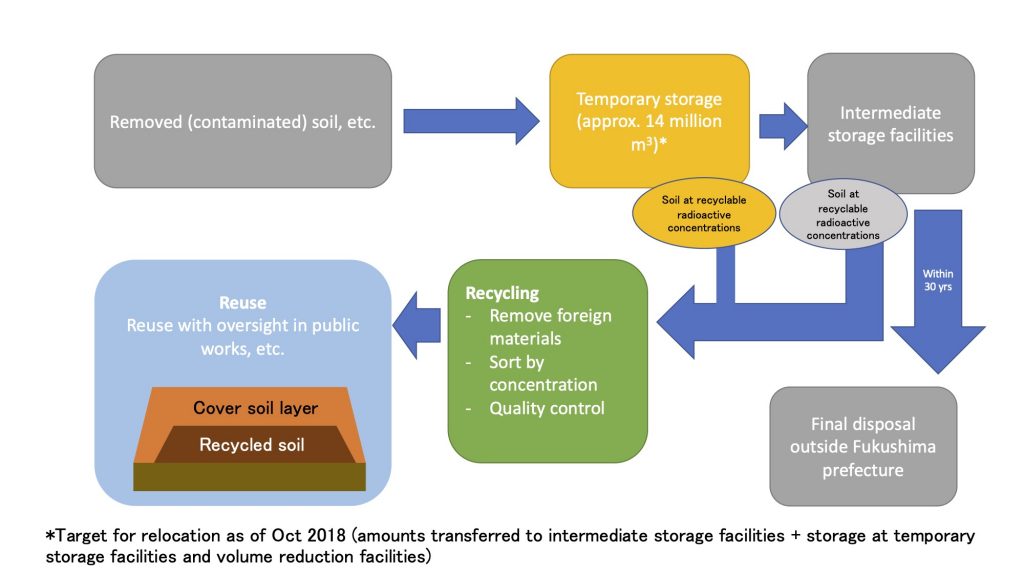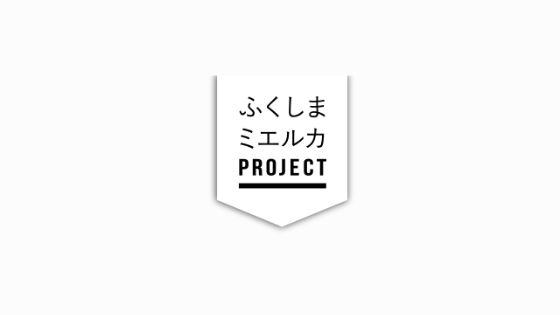
In early 2016, the Ministry of the Environment’s “Strategic Study Group for Developing Technologies for Reducing the Volumes of and Recycling the Temporarily Stored Soil and Wastes Generated as a Result of Decontamination” formulated a policy to allow 14 million m3 of contaminated soil generated from decontamination in Fukushima Prefecture, which is less than 8,000 Bq1/kg, to be used for public works projects and agricultural land development nationwide. The ministerial ordinance was scheduled to be enforced beginning April 2020, but it is “still under consideration” and has yet to be enforced.
On the other hand, in the Nagadoro District of Iitate Village, a demonstration project is underway to reuse contaminated soil in the creation of farmland, and vegetables are being grown. Mr. Koizumi, Minister of the Environment, placed a potted plant with radiation levels of 5,100 Bq/kg of contaminated soil in his office to appeal to the public on the safety of such soil[1].
The current plan is for wastes from decontamination work to be stored for up to 30 years in an interim storage facility built around the Fukushima Daiichi Nuclear Power Plant, and then transported out of the prefecture for final disposal. The policy of reusing contaminated soil from the decontamination process was formulated to reduce the amount of soil that will eventually be disposed of.
Conventionally, according to the regulations based on the Nuclear Reactor Regulation Act, materials with a cesium equivalent of 100 Bq/kg or higher have been managed as “radioactive waste” at the nuclear power plant site. The Ministry of the Environment’s new policy will allow for the use of materials 80 times higher than this level for public works and agricultural land.
According to a “guide” being prepared by the Ministry of the Environment, examples of applications include roads, seawalls, coastal disaster prevention forests, land development, water reclamation, and agricultural land. They are to be used as embankment and filling materials, and the limits of radiation levels and thickness of the soil cover are set according to the application.
However, even controlled repositories with water-shielding structures often have problems with contamination leaching into the surrounding area. When the soil is used for public works, it is not designed to be impervious to water, and moreover, in the event of a disaster such as river overflow, earthquake, or tsunami, there is a risk that the soil will collapse or spill. When contaminated soil is used as filling material for roads, it takes 170 years for the Cesium 134 and 137 to decay to 100 Bq/kg. The average lifespan of filling materials is estimated to be 70 years, and it is unclear what will happen to the contaminated soil used as material after that time.

Figure: Flowchart for the reuse of contaminated soil from decontamination (cleanup) work
Source: Ministry of the Environment, “Status of discussions about recycling/reuse of soil removed from Fukushima Prefecture” (June 2019)
Citizens oppose the project in various areas
The Ministry of the Environment had plans to conduct a demonstration project in Nihonmatsu City, Fukushima Prefecture, to use contaminated soil as roadbed material for agricultural roads. The residents of Nihonmatsu opposed for the following reasons: (1)the supposed ‘understanding of residents’ was conceived at an explanatory session which only a small portion of the residents attended, (2)it was promised that the waste would be transported out of the temporary storage area, but if it is used on agricultural roads, it could become the equivalent of a final disposal site, and (3) concerns regarding the spread of radioactive materials.
According to the plan, a 200-meter-long farm road was to be excavated, and 500 bags of contaminated soil piled up in a nearby temporary storage area were to be taken out of their bags, buried as roadbed material, and covered with approximately 50 cm of soil. In February 2018, a local citizens’ group submitted a request to the Ministry of the Environment to withdraw the project. In June, overwhelmed by opposition, the Ministry of the Environment announced its intention to withdraw the project.
In Minamisoma City, a plan to reuse the contaminated soil for the widening of the Joban Expressway in Odaka Ward, Minamisoma City, is moving forward. On February 1, 2019, a ‘group opposing the plan’ was formed by residents. The mayor of the local district of Hanokura, Odaka Ward voiced his opposition, stating that “we were promised that the contaminated soil would be transported from the temporary storage site to the interim storage facility in three to five years. This plan is being referred to as a demonstration, but once the soil is used, there is concern that it will be left there permanently.”
Reuse of agricultural land in Nagadoro District, Iitate Village: No soil cover and even vegetable production
In the Nagadoro District of Iitate Village, a demonstration project is underway to use contaminated soil for agricultural land development. 30,000 bags of contaminated soil from the village were brought to a stockyard set up in the Nagadoro Administrative District. At a recycling facility, the necessary amount was removed from their bags, foreign materials were removed from the soil, and the soil was sorted by radiation concentration. Soil with radiation levels below 5,000Bq/kg were used as levee padding for the agricultural land along the Hiso River. Initially, the plan was to grow horticultural and resource crops after covering the land with 50cm of soil, but tomatoes, cucumbers, and turnips have also been cultivated. They also grew some vegetables without covering the land with soil. The concentration of radioactive cesium in the vegetables ranged from 0.1 to 2.3 Bq/kg.
The farmland development demonstration project was conducted on 0.1 hectare of land, but there are plans to develop farmland in a larger area (34 ha). These will be implemented as part of the “Plans for Reconstruction and Revitalization for Special Zones” of Iitate Village.
“Ministerial ordinances” full of loopholes
In January 2020, the Ministry of the Environment issued a ministerial ordinance draft to revise the enforcement regulations of the Act on Special Measures against Contamination by Radioactive Materials to allow contaminated soil to be reused in public works. The Ministry of the Environment presented an overview of the draft to the public to receive feedback via public comments. Based on the results of the public comments, the ministerial ordinance was scheduled to go into effect on April 1, 2020, but later it was decided that “further study was required,” and as of January 2021, the ordinance has not been implemented.
The draft of the ministerial ordinance that was submitted for public comment did not include specific restrictions and responsibilities regarding the use of the contaminated soil, radiation concentration limits, covering, management deadlines, and information disclosure. If the ordinance is enforced in its current state, contaminated soil containing high levels of radioactive materials could be reused without the knowledge of residents. Even if contaminated soil were to spread because of sloppy management, no one would bare the responsibility.
An open discussion is needed on how to dispose of the large amounts of contaminated soil that were generated. The Ministry of the Environment should hold briefings and public hearings nationwide before deciding on a policy.
(”Fukushima and Energy Future 2021″
The original article was published March 2021)
[1]Jiji Dot Com “Quieting Harmful Rumors By Placing a Potted Plant with Decontamination Soil in the Minister’s Office-Mr. Koizumi, Minister of the Environment” (March 6, 2020) (In Japanese)

